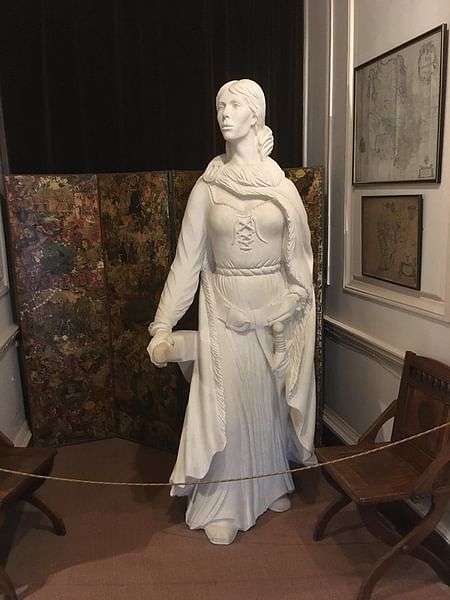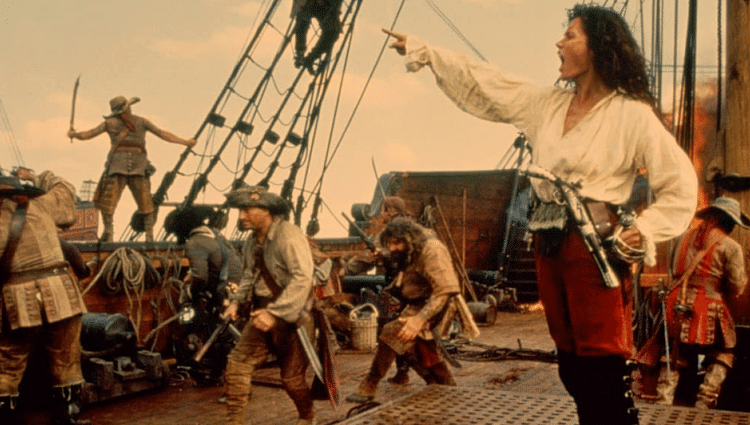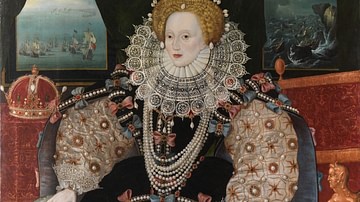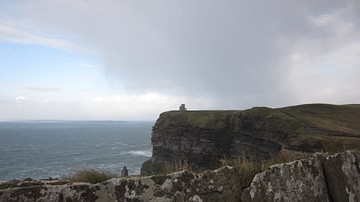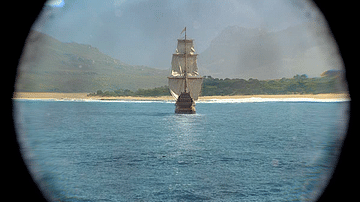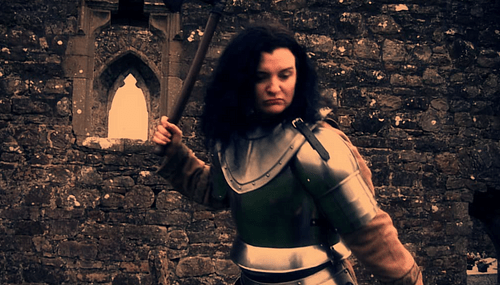
Grace O'Malley (l. c. 1530-1603) was an Irish chieftain and seafarer who became famous as a pirate and rebel during the reign of Queen Elizabeth I of England (1558-1603) who was trying to increase her control of Irish lands. O'Malley's exploits made her a folk heroine while official Irish histories tend to ignore her.
Even in the present day, Irish historians often give O'Malley the briefest treatment in a work or omit her entirely because of the understanding that she fought for her own interests and those of her family, not for the greater good of Ireland, and collaborated with Elizabeth I. Her efforts, however, did challenge English policies and tactics of divide-and-conquer initiated by Elizabeth I's magistrates, and it does not seem she kept her side of the bargain after meeting with the English queen in 1593.
Although O'Malley had promised Elizabeth I her ships and army in return for the safety and security of herself and family, she does not seem to have provided either, at least not as she specified, during the Nine Years' War (1593-1603) fought between England and the Irish forces under Hugh O'Neill of Tyrone (l. c. 1550-1616) and Hugh Roe O'Donnell of Tyrconnell (l. 1572-1602). If anything, her actions suggest sympathy with O'Neill's rebellion even if she did not personally participate in it.
Her private war with Sir Richard Bingham (l. 1528-1599), Elizabeth I's governor in Connacht, Ireland, was the reason for O'Malley's meeting with the queen. Bingham had ruthlessly suppressed Irish uprisings and even killed one of O'Malley's sons and imprisoned two others. Although he had acted in Elizabeth I's interests, she issued him orders to free O'Malley's sons and leave her in peace. Bingham predicted that O'Malley would not keep her word to the queen and would only stir up further rebellion, and he was right as she supplied the rebels with ships.
She is often referenced as "the pirate queen" and is also known as Grainne O'Malley, Grainne Mhaol, and Granualle. In the 20th century, O'Malley became an inspiration for the cause of Irish liberation from English rule, even though she had never fought for that cause, directly, in her life. She remains a popular figure in Irish lore up through the present day and her life story continues to inform Irish narratives, ballads, and works of art.
Early Life & First Marriage
O'Malley's early life prior to her first marriage is preserved almost entirely through folklore as Irish historians chose to ignore her for the reasons given above and, also, because she was thought to have overstepped the boundaries of propriety as a woman. The Irish Brehon Laws (written c. 227-266 CE) granted women equal status and a woman was regarded as her husband's partner, not his property. Even so, there were certain expectations for how a woman should comport herself, which O'Malley chose to ignore, preferring instead to live and do as she pleased.
Her father, Eoghan Dubhdara O Maille (Anglicized as Owen O'Malley), was lord of the O Maille of Clew Bay, County Mayo, and his family had a long history of seafaring. Scholar Anne Chambers elaborates:
The O'Malleys differed from the majority of Irish clans in that they derived their living mainly from the sea. Their clan motto, terra marique potens (powerful by land and sea), proclaimed them lords of the seas along the west coast of Ireland…The O'Malleys were themselves intrepid seafarers, whose seafaring was not merely confined to Ireland. A fifteenth century poem confirms what tradition has always maintained – that they regularly traded and plundered as far as Spain and Scotland. (4-5)
The O'Malleys are regularly referred to as 'pirates' but whether they fit the standard definition of that term is debated. It is possible, even probable, that Owen O'Malley raided other ships but equally so that he only exacted tribute from those he found in his territorial waters. This same term would later be applied to his daughter, "the pirate queen", but it is equally unclear how much of a pirate Grace O’Malley really was.
She had an older stepbrother about whom little is known, and her father seems to have raised her as a boy or, at least, encouraged her to follow her own heart and ignore social norms. She was well educated, which was unusual for a girl, and was fluent in Latin and, most likely, a number of other languages learned through interactions in trade, such as Spanish and French.
According to legend, when she was a young girl and was told she could not accompany her father on a sea voyage because her long hair would become entangled in the lines, she cut it off. Her hair was so short she seemed almost bald and was given the nickname Grainne Mhaol ("bald Grace"). Her father seems to have then allowed her to join him on the voyage.
Whether that story is true, O'Malley was an experienced seafarer at a young age as evidenced by the respect given her by the family of her first husband, Donal O'Flaherty, whom she married at the age of 16. The O'Flahertys were another seafaring family and allies of the O'Malleys. Author Malachy McCourt notes how "even at sixteen when she came to O'Flaherty as a bride, Granualle was a well-seasoned sailor" (120). She bore her husband three children – Owen, Maeve, and Murrough – before he was ambushed and killed by the clan Joyce while hunting.
The Joyces then advanced on Donal's castle thinking it could easily be taken since the lord was dead and there was "only a woman" to defend it. O'Malley drove them off in a counteroffensive so fierce she was compared to a hen protecting her brood, giving the fortress the name "Hen's Castle", as it is still called today.
Piracy & Iron Richard
After her husband's death, O'Malley returned to her family's lands with her children and established a base on Clare Island. She may have built, or at least improved upon, the tower house, now known as Granualle's Castle, which became one of three strongholds she maintained throughout the rest of her life. The men who had served under Donal when they were married followed her to her new home and swore their allegiance to her, suggesting she had already established herself as a strong leader who rewarded personal loyalty.
O'Malley and her crew had a number of ships at their disposal, which they used for trade and to exact tribute from passing ships, earning her the name of "pirate queen" for her efforts. Her father had died by this time, and she had assumed the title and responsibilities of Lord of the O'Malley clan, which included exacting tribute from those who plied her waters. How often she engaged in actual piracy is unclear, as it was in the case of her father, but this title has stuck with her up through the present day.
According to legend, she rescued a shipwrecked sailor (whose name is not known), and the two became lovers. Their affair was short-lived, however, as he was killed by another clan, the MacMahons, of Blacksod Bay. O'Malley hunted down and killed the murderers, slaying everyone she found in the MacMahon stronghold of Doona Castle. This event gave her another nickname, "The Dark Lady of Doona", and her reputation as a formidable adversary spread further.
In 1566 or 1567 she married Richard Burke (known as "Iron Richard" from the ironworks he owned), a prestigious landowner and chieftain who was next in line to inherit the sizeable lands of the MacWilliam clan. Burke's holdings provided O'Malley with numerous inlets from which she could launch her ships on unsuspecting vessels that encroached on her territory.
According to legend, O'Malley and Burke agreed on a 'trial marriage' – not uncommon – in which the two would remain wed for one year and could then decide to annul the union. At the end of the year, O'Malley changed the locks on Burke's castle and, when he arrived home, told him he was dismissed as her husband. If this story is true, the annulment had no effect on their partnership as Burke is said to have remained with her until his death in 1583.
The two had one son, Tibbot, known as "Toby of the Ship" because he was born aboard one of his mother's vessels and, again according to legend, the day after his birth the ship was attacked by Algerian pirates. O'Malley was below deck with her newborn when she was told the fight was going badly, and leaving her son wrapped in blankets, she appeared on the main deck with a musket, rallied her men, and turned the tide of battle. She then sailed back to the lands she and Burke held.
O'Malley & Bingham
O'Malley and Burke had bigger problems than Algerian pirates, however, in the form of English magistrates who were carrying out Elizabeth I's policy of divide-and-conquer in Ireland. These magistrates would reward one chieftain with land and various gifts for help in suppressing another clan the English considered troublesome. The Norman Invasion of 1169 had first brought the English to Ireland, and King Henry II of England (r. 1154-1189) personally established English control of the island in 1171. Since then, English control of the land had increased, and under Elizabeth I, their control expanded further.
In 1577 or 1578, the Earl of Desmond took it upon himself to advance Elizabeth I's agenda and managed to capture O'Malley and imprison her in Limerick for over a year, later moving her to Dublin, where she remained a captive. She was finally released owing to good behavior but, more likely, through the efforts of Sir Henry Sidney (l. 1529-1586), Lord Deputy of Ireland who had met O'Malley years before with his son (the poet and courtier Sir Philip Sidney) and admired her. This claim is speculative, however, as Sidney was recalled to England in 1578, and it is more likely that O'Malley was aided by others such as Sir John Perrot (l. 1528-1592) who objected to the harsh treatment of the Irish.
English aristocrats like Perrot were the minority, however, and most followed Desmond's lead of furthering Elizabeth I's goals in any way they could. Key to complete control lay in undermining the traditional social structure of the Irish which was based on the concept of the clan and an independent chieftain (lord) of that clan and its lands. In 1584, Sir Richard Bingham of England became Lord President of Connacht and began systematically dismantling the old structure through ruthless military campaigns, bribery, and pitting one Irish lord against another. Scholar Jonathan Bardon comments:
In 1585, the Lord President unveiled his ambitious scheme to impose an ordered regime upon the province he governed. This he called the 'Composition of Connacht'. The lords of the province were no longer to live by billeting their warriors on the lands of their tenants and by seizing butter, corn, and cattle as tribute. Henceforth, the employment of mercenary soldiers was forbidden. Tenant farmers would hereafter pay money rents to these lords, who in turn would pay taxes to the English crown and abide by English laws. In short, these great landowners were no longer allowed to be independent warlords. The Composition of Connacht worked quite well in southern Connacht, but it was a different matter in the northern part of the province. Here, Grainne O'Malley was among those who refused to be reconciled to the new regime. (136-137)
O'Malley mounted a resistance against Bingham, and he retaliated by killing her son Owen and imprisoning Tibbot, Murrough, and O'Malley's half-brother. O'Malley herself was also arrested, but her release was somehow arranged through the help of her son-in-law. Instead of trying to negotiate with Bingham, O'Malley decided to go over his head and speak directly with Elizabeth I herself in 1593.
Meeting with Elizabeth & Death
Official accounts of O'Malley's life come from English sources such as letters and reports Bingham sent to Elizabeth I, Sir Henry Sidney's account of their meeting, and the document known as the Articles of Interrogatory, 18 questions O'Malley had to answer in writing prior to her meeting with the queen. After answering the questions, O'Malley was brought into Elizabeth I's presence and, according to legend, refused to bow as she considered herself the queen's equal. She was searched and found to be carrying a dagger which she claimed was for her own protection and was allowed, by Elizabeth, to keep; suggesting a significant level of respect, and trust, on Elizabeth's part.
Their conversation is not recorded but was carried out in Latin as Elizabeth I did not speak Irish and O'Malley could not (or would not) speak English. The meeting seems to have lasted some time and concluded with the agreement that Bingham would release the captives and leave O'Malley alone. In return, O'Malley pledged 200 men and her fleet to Elizabeth I's service in keeping the peace in Ireland. Elizabeth sent word of the agreement to Bingham, which read, in part:
We require you to deal with her sons in our name to yield to her some maintenance for living the rest of her old years…And this we do write in her favor as she showeth herself dutiful, although she hath in former times lived out of order. She hath confessed the same with assured promises by oath that she will fight in our quarrel with all the world. (Bardon, 138)
O'Malley returned to Ireland expecting Elizabeth I's orders would be swiftly obeyed, but Bingham took his time in releasing the prisoners. He was certain O'Malley would not keep her side of the bargain, and she proved him right by lending ships to the Irish rebels under Hugh O'Neill at the outbreak of the Nine Years' War in 1593, although contrary to later 20th-century claims, there is no evidence she fought in that war herself on either side. She seems to have encouraged her sons – at least Tibbot – to fight for Elizabeth I against O'Neill's forces, however, which soured her reputation among later Irish historians.
Nothing is known of the last ten years of O'Malley's life other than a petition she sent in 1595 complaining of English troops being quartered on her lands. She is thought to have died of natural causes either at Carraigahowley Castle or her stronghold of Rockfleet Castle in 1603.
Conclusion
She lived on in folk legend up through the 20th century when she came to be associated with the cause of Irish independence from England. Her definitive biography was not written until 1979 by Anne Chambers, who notes her absence from some of the most important Irish histories:
The Annals of the Four Masters, that seminal source of Irish history compiled a few years after her death and in a place where memories of her activities were still verdant, do not even mention her name. The English State Papers, on the other hand, contain references to her as late as 1627, some twenty-four years after her death. Such bias erased from the pages of Irish history one of the most remarkable women and, in so doing, diminished our understanding of the past. However, it is a measure of her greatness that her memory was preserved by folklore. Legends are not created about insignificant people. To be remembered in folk memory is as much a tribute to, and validation of her status, as any academic treatise. (v)
In the past 40 years, O'Malley's life has received increasing attention from both commercial and academic sources. Chambers' book has played no small part in reviving interest in the so-called "pirate queen" who has since inspired songs, artwork, plays, a short film, and numerous videos about her life. She is regarded today as one of the most significant figures of 16th-century Irish history and an inspiration to those who choose to live their lives according to their own rules and by no others.
